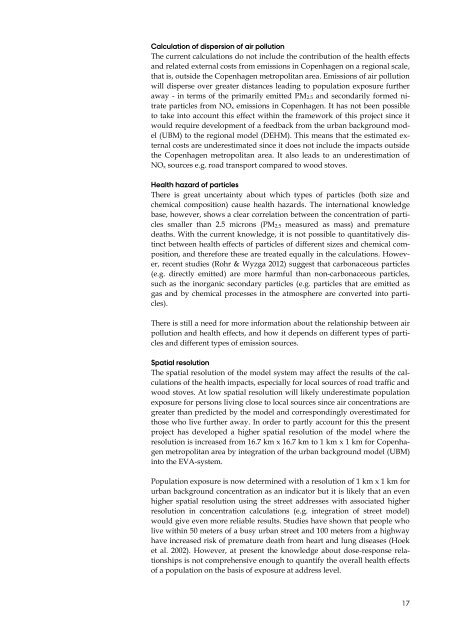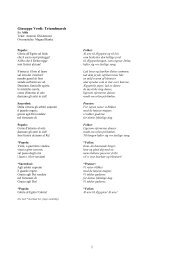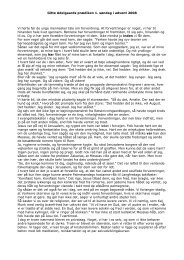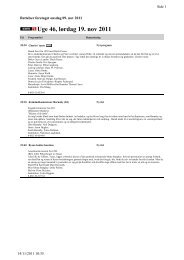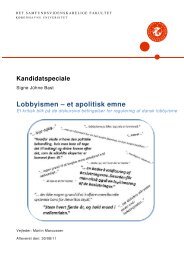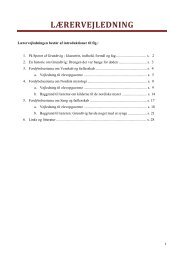Sundhedseffekter og relaterede eksterne omkostninger af ... - DR
Sundhedseffekter og relaterede eksterne omkostninger af ... - DR
Sundhedseffekter og relaterede eksterne omkostninger af ... - DR
You also want an ePaper? Increase the reach of your titles
YUMPU automatically turns print PDFs into web optimized ePapers that Google loves.
Calculation of dispersion of air pollution<br />
The current calculations do not include the contribution of the health effects<br />
and related external costs from emissions in Copenhagen on a regional scale,<br />
that is, outside the Copenhagen metropolitan area. Emissions of air pollution<br />
will disperse over greater distances leading to population exposure further<br />
away - in terms of the primarily emitted PM2.5 and secondarily formed nitrate<br />
particles from NOx emissions in Copenhagen. It has not been possible<br />
to take into account this effect within the framework of this project since it<br />
would require development of a feedback from the urban background model<br />
(UBM) to the regional model (DEHM). This means that the estimated external<br />
costs are underestimated since it does not include the impacts outside<br />
the Copenhagen metropolitan area. It also leads to an underestimation of<br />
NOx sources e.g. road transport compared to wood stoves.<br />
Health hazard of particles<br />
There is great uncertainty about which types of particles (both size and<br />
chemical composition) cause health hazards. The international knowledge<br />
base, however, shows a clear correlation between the concentration of particles<br />
smaller than 2.5 microns (PM2.5 measured as mass) and premature<br />
deaths. With the current knowledge, it is not possible to quantitatively distinct<br />
between health effects of particles of different sizes and chemical composition,<br />
and therefore these are treated equally in the calculations. However,<br />
recent studies (Rohr & Wyzga 2012) suggest that carbonaceous particles<br />
(e.g. directly emitted) are more harmful than non-carbonaceous particles,<br />
such as the inorganic secondary particles (e.g. particles that are emitted as<br />
gas and by chemical processes in the atmosphere are converted into particles).<br />
There is still a need for more information about the relationship between air<br />
pollution and health effects, and how it depends on different types of particles<br />
and different types of emission sources.<br />
Spatial resolution<br />
The spatial resolution of the model system may <strong>af</strong>fect the results of the calculations<br />
of the health impacts, especially for local sources of road tr<strong>af</strong>fic and<br />
wood stoves. At low spatial resolution will likely underestimate population<br />
exposure for persons living close to local sources since air concentrations are<br />
greater than predicted by the model and correspondingly overestimated for<br />
those who live further away. In order to partly account for this the present<br />
project has developed a higher spatial resolution of the model where the<br />
resolution is increased from 16.7 km x 16.7 km to 1 km x 1 km for Copenhagen<br />
metropolitan area by integration of the urban background model (UBM)<br />
into the EVA-system.<br />
Population exposure is now determined with a resolution of 1 km x 1 km for<br />
urban background concentration as an indicator but it is likely that an even<br />
higher spatial resolution using the street addresses with associated higher<br />
resolution in concentration calculations (e.g. integration of street model)<br />
would give even more reliable results. Studies have shown that people who<br />
live within 50 meters of a busy urban street and 100 meters from a highway<br />
have increased risk of premature death from heart and lung diseases (Hoek<br />
et al. 2002). However, at present the knowledge about dose-response relationships<br />
is not comprehensive enough to quantify the overall health effects<br />
of a population on the basis of exposure at address level.<br />
17


